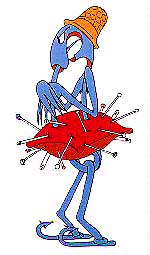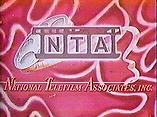Posts Tagged ‘Balloon Land’
Kit Parker Films @40 (Part 1)
Posted on: August 18, 2011
My fascination with films began with the Pincushion Man.
When I was young, everyone watched movies in the theatre or on television. That’s it…no DVD, Cable TV, Satellite, and YouTube; in fact, no digital anything. Home movie enthusiasts watched home movies on 8mm (16mm if they were lucky) and that’s about it. Then, as now, there was a big demand for movies at educational institutions, and all kinds of organizations and institutions. That need was fulfilled by 16mm film, and distribution of them was a good sized business from the 1920’s to the late 1970s. A portable 16mm projector, screen and, of course, a film was all that was required. It was a hassle, but that’s how it was done. The AV guys who ran the projectors had the same appearance and personality of computer nerds today. Film buffs remember them, but most young people won’t know what I’m talking about,
8mm was the primary format used for home movies, and my father shot a lot of them. To augment family films he showed ten minute silent versions of sound movies, mostly cartoons, which were sold in photo shops under the Castle Films label. One was The Pincushion Man, a re-title of Balloon Land (Ub Iwerks, 1935); it mesmerized me with its bizarre characters and surreal color (Cinecolor, a two color process). Dad had two others, Little Black Sambo and Sinbad the Sailor, also 1935 Cinecolor cartoons from Ub Iwerks, but to me there was Pincushion Man and then all others.
That was the origin of my interest in films. The next year I went to the movies and saw a feature film compilation of silent comedies, Robert Youngson’s The Golden Age of Comedy (1957). It was, and is, terrific. (I can’t believe it still isn’t out on DVD.) [*]
Soon after, I began collecting my own Castle Films, “dirty dupes” from Home Movie Wonderland, and eventually switching to Blackhawk Films. Blackhawk was the best; silent comedies, and the be-all-end-all of comedy, Laurel and Hardy. Then I got interested in the physical prints as well as content. My first Kit Parker Films “catalog” (three pages) offered 8mm movies for sale. I think I was 11, and my inventory came from offbeat mail order catalogs. At 13, I began borrowing 16mm public relations films produced by oil companies, railroads, and other corporations which offered them free to organizations through a distributor called Modern Talking Picture Service. They had film exchanges throughout the country, and offered countless numbers of films on the behalf of a corporate clients. By and large, they were well produced and entertaining. I told Modern there were several resorts where I lived that were interested in showing those types of films. The sources of entertainment were very, very limited in those days in semi-rural areas like Carmel Valley, California, where I grew up. Modern, who was paid by the sponsors every time a film was shown, asked me if I would sub-distribute for them. My folks took me to their San Francisco office, and when they saw me, they were stunned and amused by my age. They looked at each other wondering what they got themselves into. I got the films, though!
At 14 I started a weekly kiddie matinee at the local community center which showed a feature, short subjects and sometimes a serial, every Saturday at the local community center. Tickets sold for $.35 and it was a big success. Over the next four years, I ordered the films (the best part), ran the projector and bought the candy. The profits went to maintenance of the building.
By 14 my collecting was 100% 16mm…I bought and sold prints. As my collecting continued I also began shooting my own movies with a Bolex camera my folks gave me one Christmas. Although I never really had an interest in shooting movies, the news anchor, Mike Morisoli, at KSBW-TV (stood for “Salad Bowl of the World”!) in Salinas, California, had faith in me and provided unexposed film to cover events such as rodeos and car racing. Back then news stories were all filmed, and my footage ended up on the 6 O’clock News…way cool for a 16-year-old.
At 18, KSBW Program Director, Dwight Wheeler, hired me as the weekend film editor. In those days television broadcast only network shows, live programming (mostly the News) and lots and lots of film…no video tape. There were racks and racks of TV shows at the station, and even more feature films! At one time or another they had, MGM, Columbia, Universal, Warner Bros. and United Artists. The best distributor was NTA…they had 20th Century-Fox and Republic Pictures. Syndicated TV shows ranged from Sergeant Preston of the Yukon to Gilligan’s Island.
My job was to assemble the filmed programs and add the commercials. I had to find the best spots to insert commercials into feature films, and sometimes editing them down to fit into specific time slots. Everything had to be timed right down to the second. I learned fast because of my film experience, so soon after had lots of spare time which allowed me to study how the technical directors worked. A “TD,” as they were known, sat at a large console full of switches and buttons, like you’d see today at a recording studio. They pushed the buttons and moved levers at the correct time to assure everything went on the air at precisely the right moment. Today only live programming still uses a TD; everything else has long been computerized. During half-hour news program there could easily be scores of decisions and manipulations; most had to be anticipated five seconds ahead of the actual event. On the weekends when only the TD and I were at the station, they would teach me how to do the job. I was a fast learner and had quick reflexes, at least in those days! When one of the TD’s quit, the others recommended to the Chief Engineer that I take his place, and I went from the film room to the control room. I became akin to a super projectionist…and had a ball. A few months later I was the TD in charge of all of the prime time programming.
1967 the Viet Nam war was raging, and young men were being readily drafted. I didn’t want to end up in a jungle shooting people, so joined the Navy Reserve, and ended up on the aircraft carrier USS Enterprise. It was a small city with over 5,000 officers and men. Logically, they put me in charge of the ship’s entertainment television and radio stations; illogically they moved me into the Public Affairs Office for the duration where I worked on the daily newspaper, gave tours of the ship, and mostly shuffled papers. Morale on the ship was poor; I think our Captain idolized Captain Bligh, and my Chief Petty Officer was never happy because flogging was outlawed.
Fortunately I had enough free time to work on creating my passion, Kit Parker Films.
OF PART ONE
[*] Not to be confused with other productions on DVD with the same name.
Cool book about Castle Films:
———————-
Visit our website to order DVDs from the Kit Parker Films Collection –
Keep up to date with our new Sprocket Vault releases by liking us on Facebook www.facebook.com/sprocketvault/
Also, be sure to subscribe to our YouTube channel:




